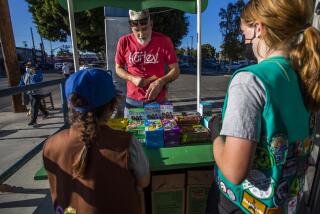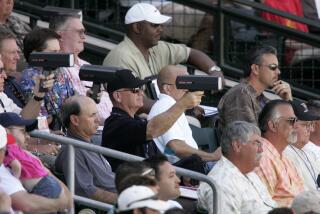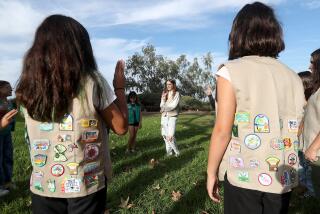Tribute Dinner Tonight for Scouting’s Innovator
“I’m with the Boy Scouts,” John Claerhout tells strangers who ask what he does.
“Oh,” the perplexed strangers often reply. “How many boys in your troop?”
About 56,000. And some of them are girls.
“I find people often can’t build a perception of someone making a living working for the Boy Scouts,” said Claerhout, who as the Los Angeles Area Council Scout Executive earns $120,000 a year.
But work for the Scouts he does, rising at 4:30 a.m. to garden at his Tarzana home and get to his office by 6:30.
Claerhout leaves in a few days to become, at $136,000 a year, the top Boy Scout official in New York City. Edward C. Jacobs, the Chicago Area Council Scout Executive, succeeds Claerhout here.
Budget Quadrupled
During his nine years in Los Angeles, Claerhout quadrupled his annual budget, from $1.3 million to $5.4 million, and expanded the staff to 46 professionals.
But, more important, Claerhout’s innovative programs brought hundreds of thousands of inner-city youngsters nationwide the basics of Boy Scouting.
The Los Angeles Area Council that Claerhout is leaving serves mostly minority areas of Los Angeles, its industrial eastern suburbs plus some of the affluent beach cities. At least 60% of the area’s children live in poverty.
While most youth agencies saw membership decline since 1976, Claerhout kept the traditional Scout programs at 38,000 youngsters.
He channeled much of the new money he raised into such no-frills programs as In-School Scouting, Career Awareness and Varsity Scouting, serving 18,000 more young people, including thousands of girls.
Refined Program
Claerhout refined the largest of those programs, In-School Scouting, which departs radically from the Boy Scout tradition of fathers serving as unpaid volunteer leaders. Instead, paid college students teach character, safety skills and other Scouting basics in the classroom to students who wear kerchiefs, but not full uniforms.
Although the Boy Scouts of America proudly claim that nearly one in three American men was once a Cub, Scout or Explorer, the volunteer leaders-only policy made Scouting mostly middle class and nearly all white.
Today two-thirds of the 413 local Boy Scout Area Councils have some form of In-School Scouting. Yet soon after In-School Scouting began 15 years ago, as a locally created experiment in Honolulu, one of the highest executives in the national Boy Scouts of America set out to kill it: John Claerhout.
Claerhout was outraged when he learned of the Honolulu experiment, which went against traditions he had honored since before he made Eagle Scout in the ‘40s.
He led an investigating team to Hawaii. But after grilling leaders, teachers and parents and talking to the poor children served by In-School Scouting, Claerhout came away its champion.
By all accounts, Claerhout is one of the most creative doers ever to rise in the sometimes stodgy Boy Scouts organization.
“It’s too bad John never got to run Scouting nationally because he’s a man of remarkable vision,” said Gerald M. Plessner of Arcadia, a professional fund-raising consultant who used to run special events for Claerhout.
Never Missed a Day
Claerhout, 56, who swims daily, looks stoutly fit in his tightly-tailored three-piece suits. On Nov. 1, he said, he will complete 33 years of work without a single day off for illness.
At the old University of Toledo, where he met Caroline, his wife, Claerhout studied acting. “We were both in theater, but never in the same play,” Claerhout said.
The Claerhouts have two grown children, one of whom is married to the son of J. R. Lewis, the San Gabriel Valley Scout Executive, and two grandchildren.
“I think John decided early to make Scouting his career, and the Scouts, recognizing his extraordinary abilities, began developing him,” said actor Philip Baker Hall, who succeeded Claerhout as president of the Woodward High School drama club in Toledo. “Even as a 17-year-old kid, John was orchestrating large Scout affairs like an adult.
“John was the most advanced child actor I ever saw . . . the most mature personality,” Hall observed. “At 17 years old, John looked 40--just like he does today.”
“That’s the best description of John I’ve ever heard,” chuckled Claerhout’s friend, Eugene R. Wilson, president of the Atlantic Richfield Foundation. “John’s always looked 40.”
As a Boy Scout, Wilson spent six summers at Camp Miakonda outside Toledo where Claerhout, just into his 20s, was camp director.
“John had hundreds and hundreds of kids, and he was responsible for feeding them, crafting them, charactering them, getting them to synagogue Friday night or Mass or services Sunday and keeping them out of trouble,” Wilson said. “John made everything go smoothly.”
Claerhout’s passion for whatever catches his fancy shows in his office near Echo Park. Images of Abraham Lincoln dominate, including at least 21 photographs or paintings and 22 metal, wood or plastic statues or reliefs of the 16th President.
“Years ago, when I ran the Chicago Scout Council, I hiked the Lincoln Trail in Illinois from New Salem to Springfield, and it was a great learning experience because I realized what Lincoln had to do to get around,” said Claerhout, a lifelong member of Lincoln’s political party.
Claerhout got his first job as a Boy Scout summer camp leader at age 14. “I worked nine weeks and got paid room, board and $25,” he recalled.
Claerhout rose to the No. 2 national executive position. When Claerhout lost out for the top spot, he came to Los Angeles.
Immediately, Claerhout began making connections among the rich and powerful. He proposed a fund-raising dinner to honor Leonard Firestone, who was returning from being U.S. ambassador to Belgium. Industrialist Justin Dart agreed to be dinner chairman, Claerhout said, if Atlantic Richfield Chairman Robert O. Anderson would be co-chairman.
Tickets sold so well that the event grossed $300,000, a phenomenal sum for the Boy Scouts in 1976. Claerhout began developing his new contacts into a network among top executives.
“When I started, some of the leading executives in Los Angeles had seen each other, at most, only six times, and their wives didn’t know each other at all,” Claerhout said. “So I worked at getting these people to know one another better--and for their wives to know one another.”
Once he got 50 executives, and their wives, to fly in their corporate jets to New Mexico for a conference on the future of the Boy Scouts. He saw to it that they all spent some time getting to know one another better.
Claerhout accommodates not just the desires, but also the concerns, of those who can help the Boy Scouts. Mayor Tom Bradley once declined to lend his name to Scout fund-raising efforts because some official Boy Scout meetings were held at the California Club, where women are not allowed to become members and there are no black members.
“We immediately stopped meeting at the California Club,” Claerhout said, noting that staying away from what is widely considered the most elite private club in the state did not slow the growth of donations.
Soon Claerhout was holding monthly luncheons and a steady stream of dinners to honor individuals ranging from former Atty. Gen. William French Smith to Frank Sinatra.
Recently Claerhout came up with a new money-making idea. He talked the chief executive officers of major downtown companies into attending a cocktail party that rising independent young businessmen could attend in return for a $250 donation to the Scouts.
“Every nonprofit agency that takes the time to learn can raise money,” he said. “There’s so much money that can be raised that we haven’t scratched the surface.”
More United Way Funds
The local Boy Scouts are so successful at charity meals--some of them during the fall when United Way member organizations are not supposed to engage in independent fund-raising--that United Way Inc. recently agreed to increase its allocation to the Scouts in return for cancellation of most of the dinners.
In New York, Claerhout plans to use his mastery of fund-raising skills to get tens of millions of dollars to expand traditional Boy Scouting and to start In-School Scouting in Harlem, the South Bronx and other poverty-stricken areas.
The New York Boy Scout organization is so financially anemic that, for all five boroughs, where nearly 8 million people live, the budget is just $1.3 million larger than for Los Angeles Area Council, where 650,000 people live.
Tonight friends are holding a dinner to honor Claerhout. But the event won’t raise any money for the Scouts. Tickets, at $25 each, will just pay for the meal.


